Spring Containers for Every Style
Whether you want a traditional tapestry or a more modern motif, these designs will kick your season off right
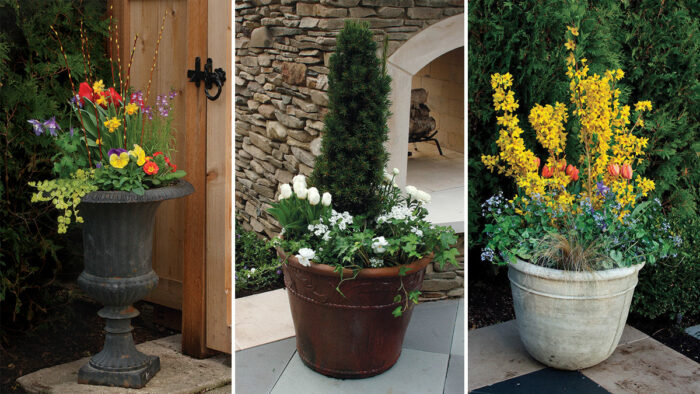
Spring containers are the most rewarding of seasonal plantings because they are symbolic of a new beginning after the winter months. They are also a way to begin gardening earlier than nature allows if the soil in your garden is still frozen.
Unfortunately, many gardeners rely exclusively on pansies to bring their pots back to life. This approach is boring and doesn’t allow your pots to display a distinctive style. There is more to spring plantings than pansies. As container-garden designers, we think that before you buy a single plant, you should pick a theme. This helps the creative process and takes spring containers to the next level by opening your eyes to many more plant and pot choices.
Get a timeless look with traditional treasures
The cast-iron urn sets the stage and helps the beautiful primary colors in this container pop. Its blackness recedes to the background, which allows you to focus on the vibrant glow from the array of traditional spring plants. Red, blue, and yellow are mirrored throughout in the blossoms and foliage, thus creating unity. The painted pussy-willow stems (which are created using a yellow exterior paint) not only echo the deeper tones of the miniature daffodils but also add needed height, because many early-spring plants are moderate in stature. You can count on family and friends questioning you on your new variety of “‘Fluorescent’ pussy willow.”
- ‘Oscar’ tulip (Tulipa ‘Oscar’, USDA Hardiness Zones 4–8)
- ‘Fantasy Blue’ fairy lights (Linaria maroccana ‘Fantasy Blue’, annual)
- Spring Magic® Blue and White columbine (Aquilegia ‘Spring Magic Blue and White’, Zones 3–8)
- ‘Tête-à-Tête’ daffodil (Narcissus ‘Tête-à-Tête’, Zones 3–9)
- ‘Goldilocks’ creeping Jenny (Lysimachia nummularia ‘Goldilocks’, Zones 4–8)
- Common primrose (Primula vulgaris cv., Zones 4–8)
- Matrix™ Morpheus pansy (Viola × wittrockiana ‘Matrix Morpheus’, annual)
Pastel perennials provide rustic panache
The casual simplicity of this grouping makes it incredibly versatile. This combo could reside happily in front of an English cottage or a suburban ranch home. We used asparagus as the focal point due to the daily changing interest as it grows—from spears, to lacelike stems, to ferny fronds. Its mature height later in spring not only will provide a nice foil for its pot mates but also balance the weight of the cast-stone pot. We used these particular perennials because their soft-colored blooms are long lasting. The real star of the bunch is Ivory Prince™ hellebore because of its form, flower shape and color, and ability to blend in easily with the tulips and Persian buttercup.
- Asparagus (Asparagus officinalis, Zones 4–8)
- Tulip (Tulipa cv., Zones 4–8)
- ‘Origami Yellow’ columbine (Aquilegia ‘Origami Yellow’, Zones 3–8)
- ‘Etain’ violet (Viola ‘Etain’, Zones 4–8)
- Persian buttercup (Ranunculus asiaticus cv., Zones 7–11)
- ‘Beacon Silver’ lamium (Lamium maculatum ‘Beacon Silver’, Zones 4–8)
- Ivory Prince™ hellebore (Helleborus ‘Walhelivor’, Zones 3–8)
- ‘Sherwood Purple’ creeping phlox (Phlox stolonifera ‘Sherwood Purple’, Zones 4–8)
Sunset hues add some southern sass
After a long winter, big, bold colorful statements in large pots are a joy to behold. Shrubs are often overlooked for use in spring containers in favor of annuals, perennials, and bulbs—but not in this arrangement. The sunset-inspired hues from the golden forsythia and the orange tulips send a strong color message; the blooms seem to glow with warmth. And when you get a bit closer to the pot, the textures of the brunnera, the Mexican feather grass, and the columbine lend the container design even more appeal.
- Magical® Gold forsythia (Forsythia × intermedia ‘Kolgold’, Zones 5–9)
- ‘Jack Frost’ brunnera (Brunnera macrophylla ‘Jack Frost’, Zones 3–7)
- Tulip (Tulipa cv., Zones 4–8)
- Spring Magic® Blue and White columbine (Aquilegia ‘Spring Magic Blue and White’, Zones 3–8)
- Mexican feather grass (Nassella tenuissima, Zones 7–11)
Develop a sleek look with one color
There is a reason why white is so popular: Whether the color is of a car or a carnation, white has strong visual weight yet works with everything. The dark green needles and dense silhouette of the yew balance the bulk and dark color of the pot while serving as a backdrop for the bright luminescent blooms of the other plants in the container. This monochromatic combination with its strong lines will be pleasing no matter where the pot is placed.
- ‘Viridis’ yew (Taxus × media ‘Viridis’, Zones 5–7)
- Bacopa (Sutera cordata, Zones 10–11)
- Tulip (Tulipa cv., Zones 4–8)
- Pansy (Viola × wittrockiana cv., annual)
- ‘Purity’ candytuft (Iberis sempervirens ‘Purity’, Zones 5–9)
- ‘Bloomingdale White’ Persian buttercup (Ranunculus asiaticus ‘Bloomingdale White’, Zones 7–11)
- English ivy (Hedera helix cv., Zones 5–11)
Stick to blues and whites for a shoreline style
The power of white—especially when represented by a bold flower, like that of this hydrangea—combined with the washed blue of this glazed pot is a show-stopper, up close or from a distance. The slender but interesting curly-willow stems relieve the density of the hydrangea and keep the blooms from looking like bloblike snowballs. The silver-hued licorice plant and lamium act as cool neutrals, which give the eye a place to rest, while the trailing lobelia flows over the edge, marrying the plants to their beautiful container.
- Bigleaf hydrangea (Hydrangea macrophylla cv., Zones 5–9)
- Lobelia (Lobelia erinus cv., annual)
- ‘Icicles’ licorice plant (Helichrysum thianschanicum ‘Icicles’, Zones 10–11)
- ‘Pink Pewter’ lamium (Lamium maculatum ‘Pink Pewter’, Zones 4–8)
For a vintage aesthetic, recycle the pot and infuse edibles
This design proves that anything is a candidate for a fun container. Lettuce comes in a wide range of colors and textures, but to add even more interest, we interspersed nearly identical colored pansies and Johnny jump-ups to complete this edible arrangement. The coarse texture of the greens contrasts well with the delicate blooms of the flowering annuals. Lettuce can be seeded directly into the vessel, or you can use transplants from the nursery. And you never have to worry about good drainage with this container. This planting should spark interesting conversations at outdoor meals.
- ‘Allstar Gourmet Mix’ lettuce (Lactuca sativa ‘Allstar Gourmet Mix’, annual)
- ‘Whiskers Purple and White’ pansy (Viola × wittrockiana ‘Whiskers Purple and White’, annual)
- Johnny jump-up (Viola tricolor, Zones 3–9)
Start strong and keep it going
Although all of the designs in this article are beautiful, they will inevitably take a few weeks to fill in and look lush. This is because of cool and often unpredictable spring weather. If you’re searching for a quick-and-easy spring pot that looks good overnight and continues to put on a show in the months to come, follow this step-by-step recipe.
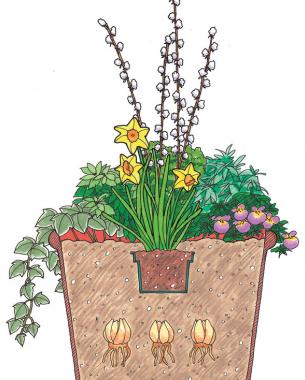
Step 1
Fill a 14-inch-diameter pot with a few inches of potting soil, place in three Asiatic lily bulbs (Lilium cv., Zones 3–8), then fill the rest of the pot with soil to just below the lip.
Step 2
Plant a 4-inch-diameter forced bulb (still in its planting pot) in the top middle of the pot, and then fill in around that plant with five other 4-inch-diameter annuals and herbs. Plant the remaining bare spots with pansies, then stick a few ornamental stems (like those of pussy willow) into the pot to add height.
Step 3
Deadhead the annuals as they finish blooming, and remove the entire 4-inch-diameter pot of bulbs when it starts to fade. The lilies will eventually grow up through the space left in the middle of the pot and through the other plants. The lilies will flower in early summer.
Jennifer Brennan and Tony Fulmer are gardening professionals at Chalet, a nursery in Wilmette, Illinois.
Photos: Danielle Sherry


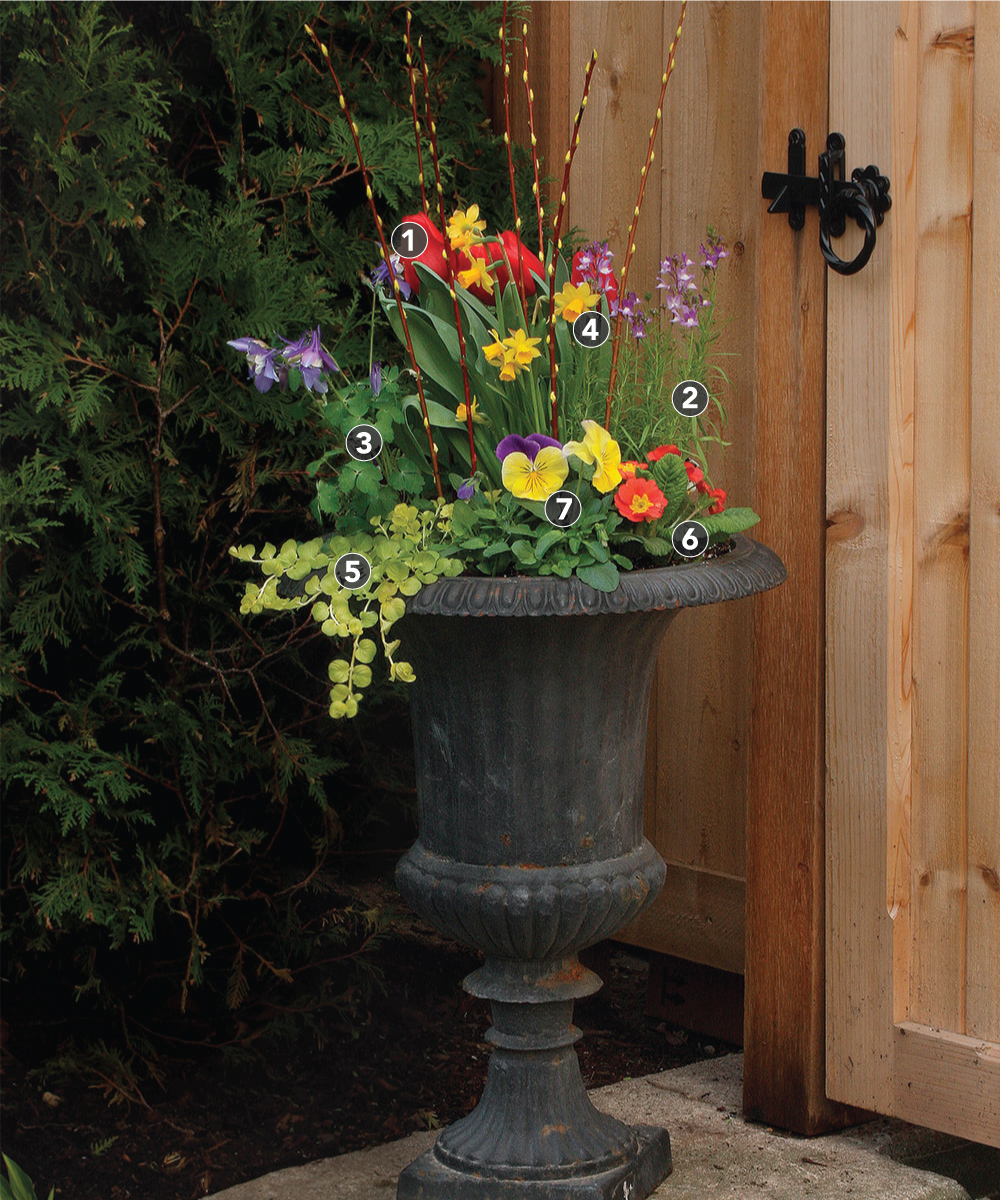
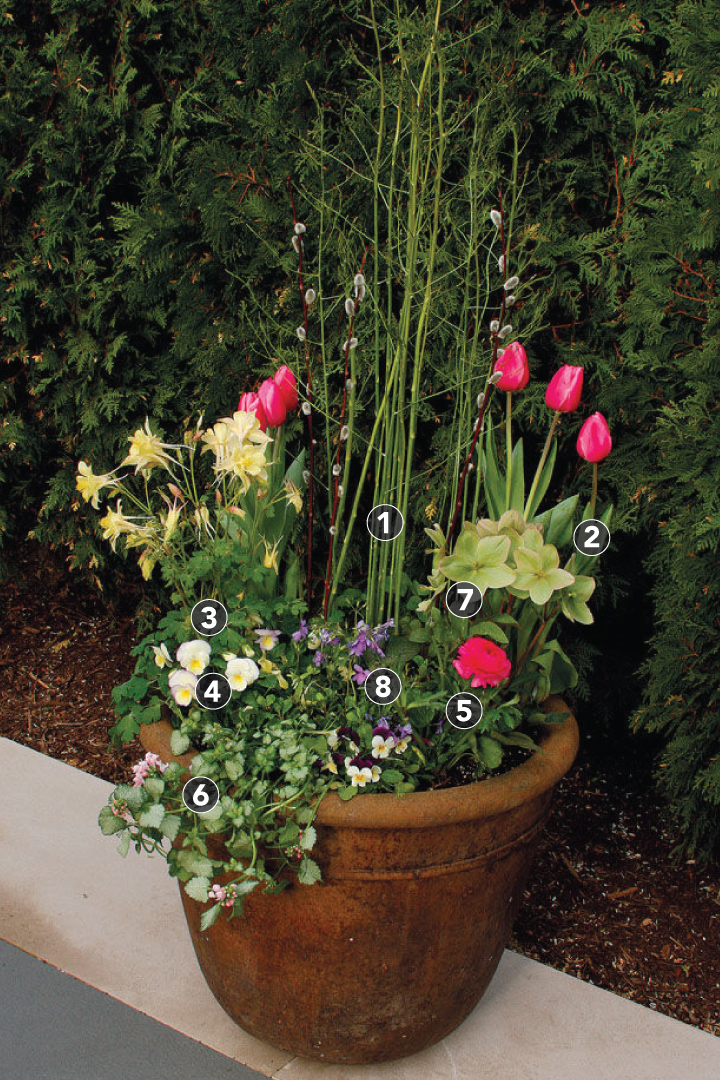
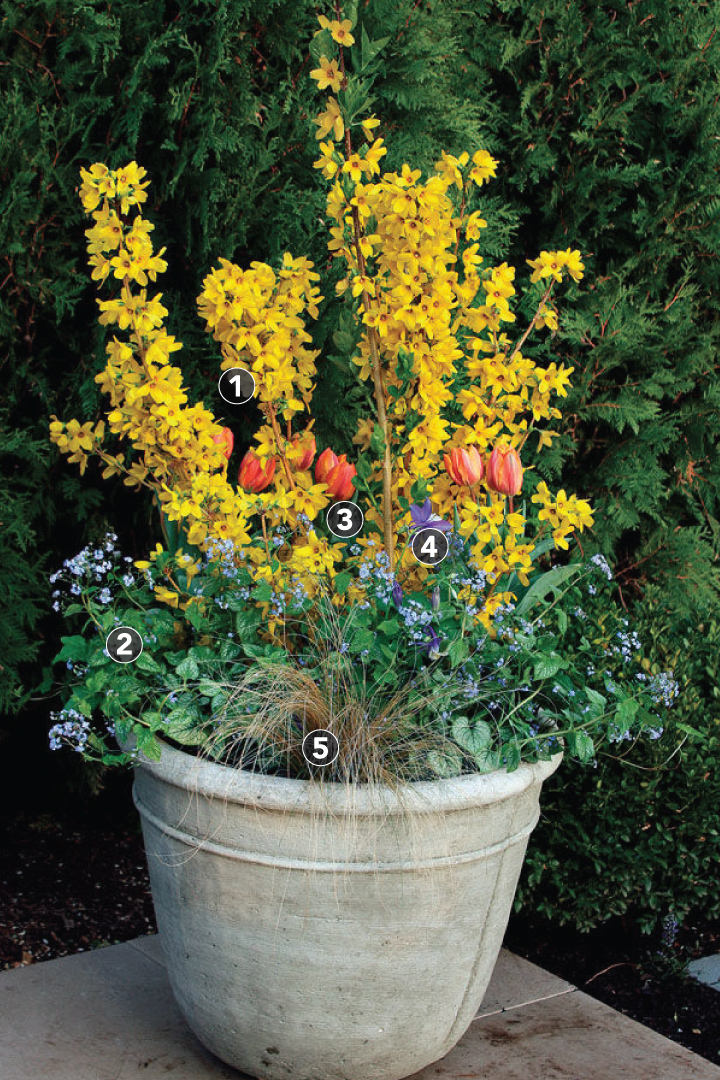
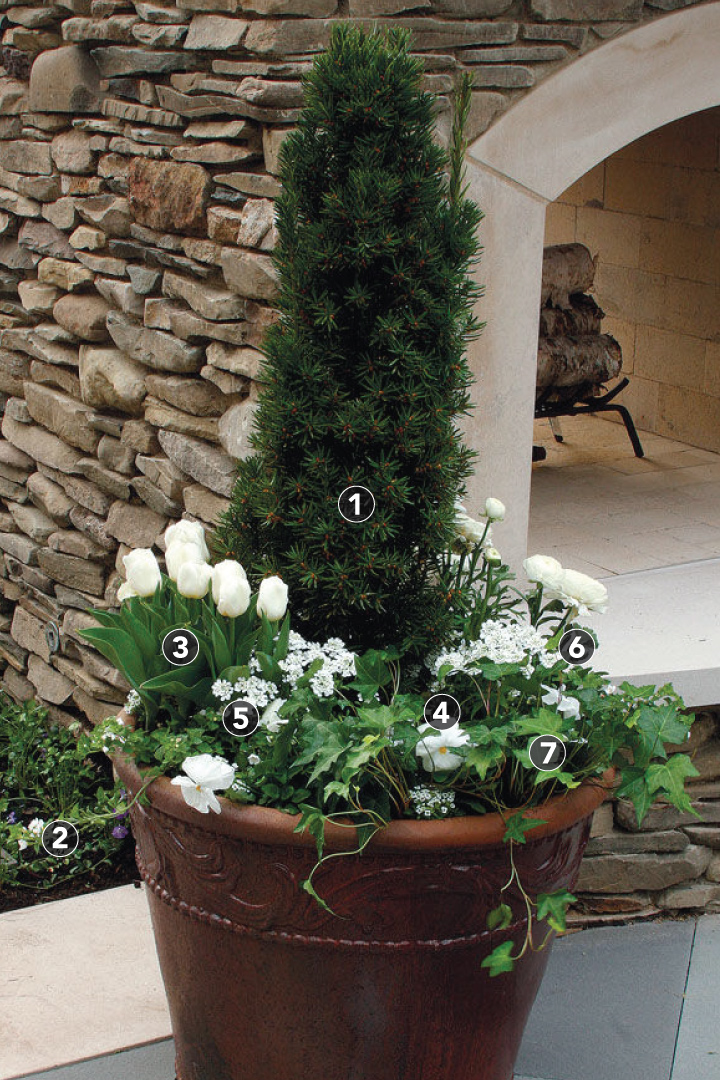
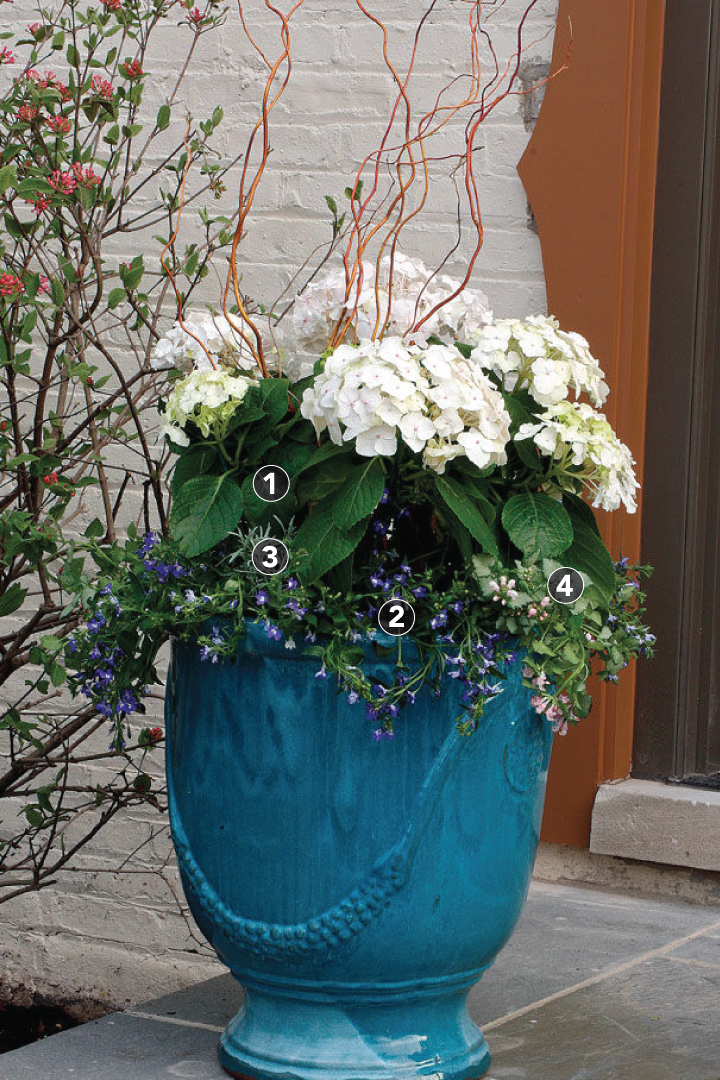
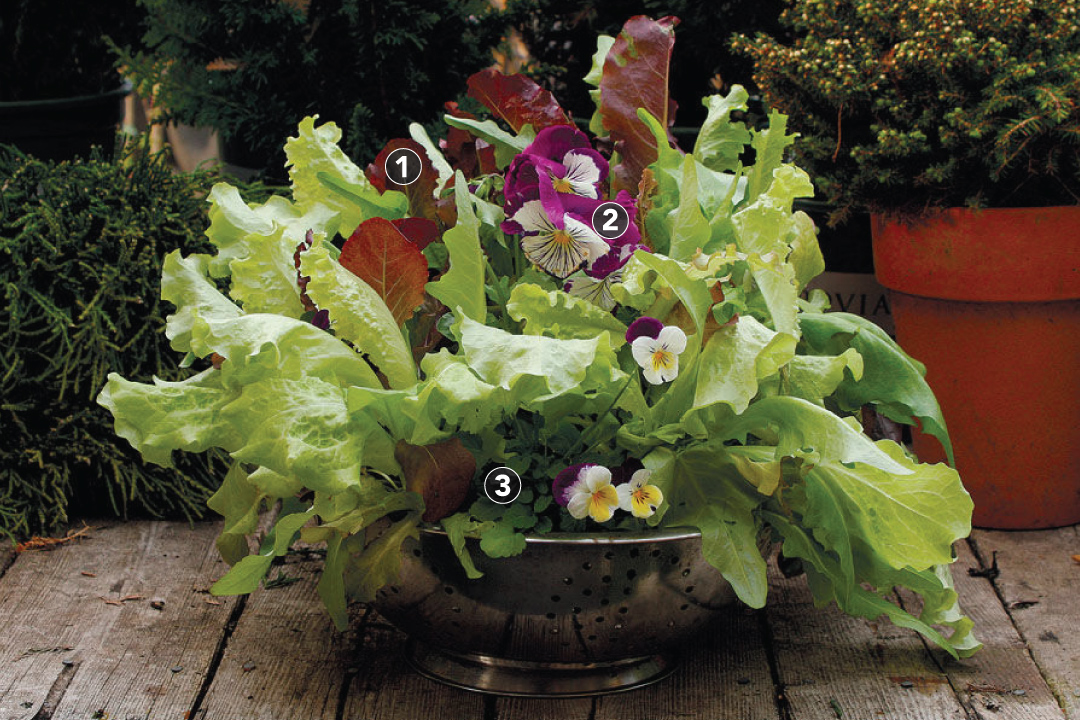



Comments
Nice the way you show the photo and then list exactly what is growing in it. Sort of like a recipe! I'm inspired to make some pots.
so beautiful
marvelous!
Log in or create an account to post a comment.
Sign up Log in